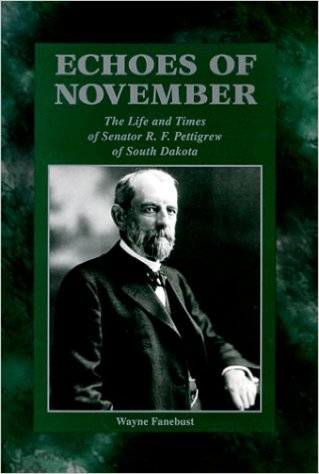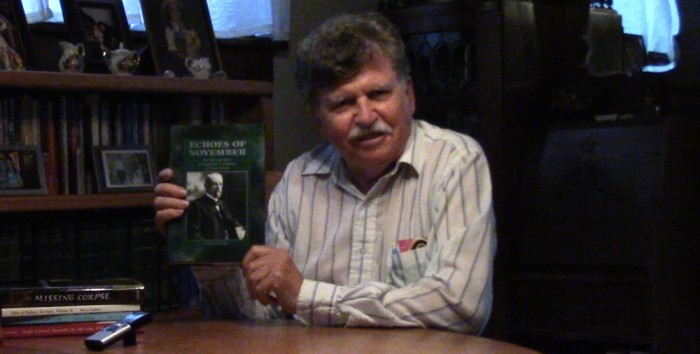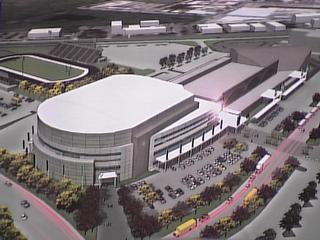Wayne wrote this post for me back in November of 2015 and came to the city council meeting tonight to talk about it during public input.
I asked local author Wayne Fanebust to write a guest post about what would Pettigrew think of modern day Sioux Falls.
R.F. Pettigrew served in the U. S. Senate from 1889, the year South Dakota became a state, until 1901, when he was defeated by the McKinley/Hanna Republican machine. Before, during and after he served in the senate, he was strenuously devoted to making Sioux Falls into a great city. What would he think of his creation as it exists today? My response to that question will be based upon my biography of the man entitled: Echoes of November, the Life and Times of Senator R. F. Pettigrew from South Dakota. Doing the research enabled me to get to know him well.
Pettigrew first came to Sioux Falls in 1869, as a member of a federal surveying company. The town, begun in 1856, had been abandoned and destroyed in 1862 by the Sioux Indians. In its place was a military installation called Fort Dakota.  The twenty-year old Pettigrew camped out with his comrades at or near the Fort. He fell in love with the area and while sitting around a campfire, he must have seen a city in the making. Most certainly he understood the raw potential for a great city near the powerful and roaring falls. He was young, well-educated, and he possessed a keen and powerful intellect, along with a single-minded personality. He was ideally suited to building a city from scratch and he was in the right place at the right time to do it.
Since he was a self-made man, as the 19th century expression went, he admired men who pulled themselves up by their boot straps and carved out successful lives on the frontier. Pettigrew was a capitalist in accordance with the parlance of his time, but he was a main-street, not a Wall Street, entrepreneur. Since he identified with the “mom and pop†businesses, he would today, be pleased to see so many small businesses, restaurants and shops in Sioux Falls. But because his hatred of the “gold bugs†in New York, he would be displeased to see brokerage firms on the city streets. Perhaps, however, his dislike for “wall street gamblers,†would be tempered by the presence of the SEC that regulates the sale of stock. He most certainly would have approved of regulating the markets.
In politics, Pettigrew evolved from a stalwart Republican to a Populist, and finally to the Democratic Party. He left the party of Lincoln when he saw that it was no longer the party of Lincoln. He became thoroughly caught up in the progressive movement of his time and therefore would be proud to see that Sioux Falls has a public transportation system and regulated utilities because he believed that such things as lights, water and sewerage should be run for service rather than for profit. The interstate highway running through Sioux Falls would be especially pleasing to Pettigrew because he and his fellow progressive fought for a federally funded interstate highway system, with railroads, of course. The city park system would meet with his approval too.
In his time, anyone who stood in the way of progress was derisively called a “kicker†or a “croaker.â€Â That label was freely applied to anyone who did not pitch and do his part to help Sioux Falls grow. Pettigrew was a pushy, “get with it or get out of the way†kind of man and often prodded other city leaders when he felt that they were lacking in energy and dedication. When he wanted something, he wanted it desperately.    With this in mind, Pettigrew would be pleased to see that Sioux Falls had facilities such as the Washington Pavilion and the Event Center, because these projects would be seen by him as people coming together for the public good. New ideas were always welcome in his circle of allies.  Enough talking, let’s do it! No one in his time would ever accuse him of thinking anything but big. For example, the Queen Bee Mill was one of his projects. He took pride in it even though it was a colossal failure.
He would be very proud that his city, Sioux Falls, was far ahead of other South Dakota cities—especially Yankton–in population and innovation. The Yankton oligarchy and its newspapers treated him roughly in the territorial era, and he never forgave them. The size of Sioux Falls would surprise him, but since he was fond of the farmer, the sprawling city with concrete and asphalt covering up the good soil, would have been cause for concern. He was not a scientist but he believed in science and after seeing how new technology creates greater crop yields he probably would come to terms with the loss of acreage under the plow.
Pettigrew was a believer in education for he understood that a culture that does not educate its people is doomed to fail; it will descend into a spiral of crime and punishment. Therefore the great proliferation of schools in the city would please him. Seeing his name of an elementary school would have given him great pleasure. Thank you very much; you didn’t forget me after all. While he never joined a church, he understood the importance of churches in the overall health of a community and seeing that so many existed would have caused him to nod in the affirmative.  Although he was not religious, he understood that religion can form the basis of good morality.
He did not have time for art or music, but once again, he understood their value to a city. In the 1890’s he had plans for constructing a grand “Pettigrew Opera House†on Phillips Avenue. Therefore the music and other entertainment venues that we have today would meet with his approval. In other words, he would have voted in favor of creating the Pavilion and building the EC, but would have insisted that they be built with local talent, materials and labor. In his lifetime, he valued local stone and promoted its use for building, and seeing that we saved the old Washington High School building would put a gleam of approval in his eye. The same for the federal building constructed in 1894, on 12th and Phillips; it was his baby that came to fruition during his time in the Senate.
The development along 41st Street would be a real eye-opener to Pettigrew for it was along that street that he envisioned and created an industrial suburb that was known as South Sioux Falls. The financial crash of 1893 disrupted and then destroyed his plans, and that of his fellow investors. Therefore seeing it developed and thriving, and providing jobs would have validated, to a certain extent, his dream for doing some similar.
Above all else, Pettigrew was a politician; he loved the give and take, the debate, the hard struggle to get votes and win office. For decades he was thoroughly immersed in the world of politics and he knew full-well how it can, in turns, unite and divide. He was also all too familiar with the smoke-filled, back-room deal-making that could make or break a politician. It was dirty business but he grew to power because he knew how to do it well. For this reason, nothing that the local government does today would concern him at all. In fact, he would probably look upon our system as superior to that of his day, when deal making ruled the political process and the average person was completely left out. Although far from perfect, our process is less corrupt than the system of Pettigrew and his fellow travelers.
As Pettigrew’s thinking evolved, his political system made room for women, farmers and working people. Late in life he spoke out in favor of a more inclusive political discourse and involvement. He believed that the people who did work, created the wealth, and therefore the working people were entitled to a fair share of the wealth that they created. In his mind, the ruling classes only manipulated wealth and therefore their contributions were weak. As such, he would be disappointed to learn that wages in this country had stagnated and that the billionaire class had unfairly claimed the lion’s share of the wealth. The poverty, hardship and hunger caused by low wages would have forced him to conclude that our political and social system was failing because it created and tolerated the income gap. That South Dakota is a low-wage state would make him angry. He would take to the stump and tell people to grab their pitchforks and ax-handles and take to the streets.
There is one development in Sioux Falls that I believe would impress him to the core, and come close to bringing him to tears. When he died, Pettigrew willed his home and its contents, including his historical and archeological collections, library and personal papers to the city. It was his wish that the city create a museum and library that the public would have access to for educational purposes. But because of his “radical†ideas (public libraries, female suffrage, fair wages, direct election of U. S. senators, to name a few) the city rulers were not at all anxious to follow his wishes. Nevertheless, the old haters died, good sense finally prevailed and Pettigrew would be very, very proud to see his home and the Old Courthouse, combined into the Siouxland Heritage Museums. For Pettigrew wanted to be remembered by the people of the city he worked so hard to build.

Echoes of November, The Life and Times of Senator R. F. Pettigrew of South Dakota
This is a comprehensive biography of Sen. R. F. Pettigrew, the first full-term Senator from the state. He went from a young, ambitious man on the wild Dakota frontier to the U. S. Senate. Pettigrew was a leader in the fight for the division of Dakota Territory and the admission to the Union. A man of vision, intellect and controversy, he became one of America’s premier political figures. He served two terms in the Senate and among his noted accomplishments was a law that created the National Forest system. He and other renegade Republicans bolted the 1896 National Convention, joining the Populist movement. Late in his second term, Pettigrew was a leader in the Anti-Imperialist League that arose out of the U. S. invasion of the Philippine Islands. Pettigrew’s attacks on the McKinley administration raised caused his name to become a household word. During World War I, his outspoken opposition to America’s involvement in the war resulted in an indictment under a law that punished anti-war speech. Pettigrew was never brought to trial although President Woodrow Wilson wanted very much to imprison him. He died in 1926.
456 pages including photographs, reference notes and index. It was published in 1997.

Wayne Fanebust was born in Sioux Falls, SD and raised “out in the country†always living near Sioux Falls, except for a short stay in Iowa. His early years were entirely rural and my elementary education was attained in small, wooden country schoolhouses.
He graduated from Washington High School in Sioux Falls, joined the United States Marine Corps and was stationed at Camp Pendleton, California.
In the fall of 1964, after being discharged from the Marine Corps, he attended one semester of college at Augustana College. But music was in his blood, so in 1965 Wayne moved to Los Angeles and pursued a career as a rock ‘n roll musician and songwriter. As a guitar player he sang and performed in rock bands in Los Angeles in the mid-and late 60’s.
It was while he was a student at the University of California, Santa Barbara, that he acquired an interest in history. He took a course called “History of the American West†and found he was fascinated with the frontier experience and how it shaped the American character. He graduated with a degree in history from UCLA in 1973.
Wayne attended law school at Western State University College of Law in San Diego and received a Juris Doctor of Law Degree. He was admitted to the California bar in 1980. He entered into private law practice in San Diego and maintained a law office until 1993 when he returned to Sioux Falls for a career change.  After 14 years of work as a corporate attorney in Sioux Falls, he is now retired from professional life and is very active in the business of writing.
His most recent book is Major General Alexander M. McCook, USA, A Civil War Biography.
 Other books include Echoes of November, The Life and Times of Senator R. F. Pettigrew of South Dakota and Cavaliers of the Dakota Frontier




